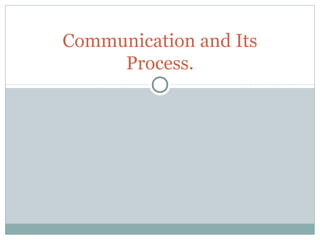Process of communication
•Als PPT, PDF herunterladen•
367 gefällt mir•449,599 views
Melden
Teilen
Melden
Teilen

Empfohlen
Empfohlen
Weitere ähnliche Inhalte
Was ist angesagt?
Was ist angesagt? (20)
Communication - Process & Definition Power Point Presentation

Communication - Process & Definition Power Point Presentation
Andere mochten auch
Andere mochten auch (20)
Ähnlich wie Process of communication
Ähnlich wie Process of communication (20)
COMMUNICATION PROCESS; COMMUNICATION EFFECTIVENESS & FEEDBACK

COMMUNICATION PROCESS; COMMUNICATION EFFECTIVENESS & FEEDBACK
Mehr von Sweetp999
Mehr von Sweetp999 (20)
Kürzlich hochgeladen
Mehran University Newsletter is a Quarterly Publication from Public Relations OfficeMehran University Newsletter Vol-X, Issue-I, 2024

Mehran University Newsletter Vol-X, Issue-I, 2024Mehran University of Engineering & Technology, Jamshoro
Kürzlich hochgeladen (20)
ICT Role in 21st Century Education & its Challenges.pptx

ICT Role in 21st Century Education & its Challenges.pptx
Seal of Good Local Governance (SGLG) 2024Final.pptx

Seal of Good Local Governance (SGLG) 2024Final.pptx
Mixin Classes in Odoo 17 How to Extend Models Using Mixin Classes

Mixin Classes in Odoo 17 How to Extend Models Using Mixin Classes
Z Score,T Score, Percential Rank and Box Plot Graph

Z Score,T Score, Percential Rank and Box Plot Graph
Basic Civil Engineering first year Notes- Chapter 4 Building.pptx

Basic Civil Engineering first year Notes- Chapter 4 Building.pptx
Unit-V; Pricing (Pharma Marketing Management).pptx

Unit-V; Pricing (Pharma Marketing Management).pptx
Process of communication
- 2. Communication is the art of transmitting information, ideas and attitudes from one person to another. Communication is the process of meaningful interaction among human beings. Personal process Occurs between people Involves change in behaviour Means to influence others Expression of thoughts and emotions through words & actions. Tools for controlling and motivating people. It is a social and emotional process. What is Communication?
- 3. Features of Communication Two-way Process Information Sharing and Understanding Verbal and Non-Verbal. Circular Flow. Goal Oriented. Continuous Process Pervasive Activity.
- 5. Message: Message is a key idea that the sender wants to communicate. It is a sign that elicits the response of recipient. Communication process begins with deciding about the message to be conveyed. It must be ensured that the main objective of the message is clear.
- 6. COMPONENTS OF COMMUNICATION PROCESS Sender / Encoder Sender / Encoder is a person who sends the message. A sender makes use of symbols (words or graphic or visual aids) to convey the message and produce the required response. For instance - a training manager conducting training for new batch of employees. Sender may be an individual or a group or an organization. The views, background, approach, skills, competencies, and knowledge of the sender have a great impact on the message.
- 7. Encoding – Encoding is the process where the information you would like to communicate gets transferred into a form to be sent and decoded by the receiver.
- 8. Channel – Channels are the way you convey your message. These channels include verbal such as telephone, and face-to-face conversations as well as non-verbal such as e-mail and text messaging. Each individual channel has its strengths and weaknesses in terms of communicating. For instance - Written medium is chosen when a message has to be conveyed to a small group of people, while an oral medium is chosen when spontaneous feedback is required from the recipient as misunderstandings are cleared then and there.
- 9. Decoding – Decoding is on the receiving end of communication. This stage is just as important as encoding. Communication can go downhill at this stage if the receiver is not practicing active listening skills or if they do not possess enough information to accurately decode the message
- 10. Receiver - Receiver is a person for whom the message is intended or aimed. The degree to which the decoder understands the message is dependent upon various factors such as knowledge of recipient, their responsiveness to the message, and the reliance of encoder on decoder.
- 11. Feedback - Feedback is the main component of communication process as it permits the sender to analyze the efficacy of the message. It helps the sender in confirming the correct interpretation of message by the decoder. Feedback may be verbal (through words) or non-verbal (in form of smiles, sighs, etc.). It may take written form also in form of memos, reports, etc.
